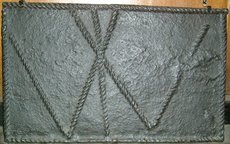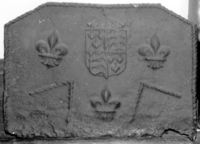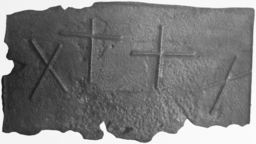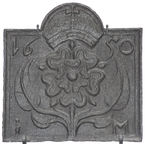-
208
Description: Canted rectangle; twisted rope edging (top and sides); quasi-symmetrical arrangement of four fleurs-de-lys in star, top centre, two fleurs each side along top edge, single fleurs beneath outer top fleurs; short rope length in vertical and inverted 'V' shapes each side between top fleurs; ?dagger handle irregularly positioned centre left and right.
Notes: The style and shape of the fleurs-de-lys is unique to a particular series of firebacks, suggesting the same source; the 'V' shapes may have apotropaic significance. A sketch of this fireback c.1891 is in the collection of J. Starkie Gardner's sketch books at the Victoria and Albert Museum, Archive of Art and Design (AAD/2014/8); at the time of drawing it was stated to be in the ownership of one Simmons, a furniture dealer of Lewes.
- Decoration tags:
- rectangular with canted top corners (shape)
- rope (edging)
- simple stamps
- carved stamps
- heraldic
Manufactured: in the mid-16th century in the Weald area of England.
Current location: in private hands, Cox Green, Berkshire, England.
- Attached to series:
- Royal series
-
78
Description: Sub-rectangular; twisted rope edging; lengths of twisted rope arranged to form two 'V' shapes and an 'I' overlapping to forma possible monogram.
Notes: The 'monogram' comprises different length pieces of rope and may have an apotropaic significance, the double 'V' referring to the Virgin Mary.
- Decoration tags:
- rectangular (shape)
- rope (edging)
- simple stamps
- apotropaic
- objects
Manufactured: in the 16th century in the Weald area of England.
Current location: Guildford Museum, Guildford, Surrey, England.
Museum number: G.488 (part of the Guildford Museum museum group)
- Attached to series:
- Rope design firebacks
-
124
Description: Canted rectangle; twisted rope edging (top and sides); top centre, crowned Tudor royal shield; fleur de lys on each side and below; slanting, inverted 'V' of twisted rope on each side of lower fleur.
Notes: One of a large series of firebacks incorporating Tudor heraldic stamps; the 'V' shapes may have apotropaic significance.
Arms: Tudor royal arms of England
- Decoration tags:
- rectangular with canted top corners (shape)
- rope (edging)
- simple stamps
- carved stamps
- heraldic
- apotropaic
- armorial
- objects
Manufactured: in the mid-16th century in the Weald area of England.
Current location: Hastings Museum and Art Gallery, John's Place, Bohemia Road, Hastings, East Sussex, England.
Museum number: HASMG: 1904.32 (part of the Hastings Museum museum group)
- Attached to series:
- Royal series
-
1118
Description: Rectangular; twisted rope edging (top and sides); initials in top corners; below the initials, a saltire formed of possibly two straight lengths of twisted rope.
Notes: The saltire is likely to have an apotropaic purpose; the hollows in the risers of the letter 'H' and the end of the left line of the saltire may have been formed by gas bubbles in the molten iron during casting.
Inscription: N H
- Decoration tags:
- rectangular (shape)
- rope (edging)
- simple stamps
- individual letters
- apotropaic
- text
Manufactured: in the early- to mid-17th century in England.
Current location: in private hands, Isleworth, London, England.
- Attached to series:
- Rope design firebacks
-
1046
Description: Sub-rectangular shape; twisted rope edging (top and sides); two crosses between two saltires, all formed of straight lengths of twisted rope and irregularly arranged.
Notes: A poorly cast, and probably early, fireback. Formerly part of the J. H. Every collection.
- Decoration tags:
- rectangular (shape)
- rope (edging)
- simple stamps
- apotropaic
- objects
Manufactured: in the early- to mid-16th century in the Weald area of England.
Current location: Anne of Cleves House, Southover High Street, Lewes, East Sussex, England.
Museum number: LH000.917 (part of the Sussex Archaeological Society museum group)
- Attached to series:
- Rope design firebacks
-
1294
Description: Rectangular shape; cavetto-moulded edging (top and sides only); top left, initials IL and top right, 1697.
Notes: The style of lettering and numerals indicate that this is a casting from a larger group produced between the late-1660s and late 1690s.
Inscription: IL 1697
- Decoration tags:
- rectangular (shape)
- cavetto (edging)
- carved stamps
- individual letters
- individual numbers
- text
Manufactured: in 1697 in the Weald area of England.
Current location: Parham House, Parham, West Sussex, England.
- Attached to series:
- 1660s-90s Wealden series
- Date & initials firebacks
-
750
Description: Arched rectangular shape; cavetto edging; crowned rose with symmetrical leaves; date split across top; initials split across bottom.
Notes: The hooked ‘1’ and ‘IM’ suggests a common pattern-maker with other firebacks bearing those features.
Copies of this fireback are known.
Inscription: 16 50 / I M
- Decoration tags:
- rectangular with round arch (shape)
- cavetto (edging)
- whole carved pattern
- planklines
- heraldic
- royal
- text
Manufactured: in 1650 possibly at Brede Furnace in the Weald area of England.
Current location: Victoria & Albert Museum, Cromwell Road, Kensington & Chelsea, Greater London, England.
Museum number: M.113-1953 (part of the Victoria & Albert Museum museum group)
- Attached to series:
- IM series
- Small cavetto series
- Hooked '1' series
- Brede group






